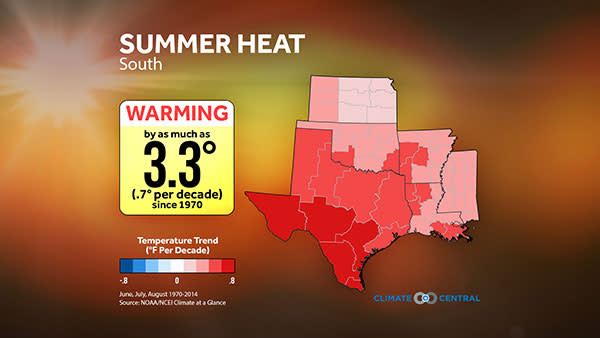Meteorological summer (June, July, and August) is already underway, but this Sunday (12:39pm ET) marks the beginning of astronomical summer. And nationwide, summers are getting hotter as greenhouse gases continue to climb.
Hotter days increase the incidents of heat stress and heat exhaustion. Additionally, air conditioners must work harder, placing higher demands on the nation’s aging power grid and increasing electrical bills. Heat waves often come with large domes of hot air with little movement. This leads to air stagnation and trapped pollutants, further worsening air quality and increasing respiratory stress.
In this analysis, we look at temperature trends across the contiguous U.S. during meteorological summer. In all of the NCEI (formerly NCDC) climate regions, there has been a warming trend since 1970. However, within those regions are smaller climate divisions where we see a more varied rate of warming. For example, in the Northern Rockies and Plains Region, a few divisions have shown a slight cooling since 1970 while others have warmed as much as 1.99°F — leading to an overall warming for the region. Nationwide, the most dramatic warming is evident in parts of the East Coast and the Southwest where temperatures in some of those divisions have risen more than 3°F since 1970.
This serves as a reminder that even in an overall warming world, not all locations will warm uniformly.Summer precipitation trends are not quite as distinct. As both evaporation rates and heavy rainfall events increase in a warming world, this lends itself to bigger variations in precipitation. While there will be some exceptions, wet areas generally get wetter, and dry areas generally get drier.
For example, despite the 5-year drought that was recently busted in Oklahoma, most of that state has an upward trend in summer rainfall, further indicating the feast or famine that can come with rainfall in the Plains. Summer is also the rainy season in Florida, and parts of Central Florida have seen an increase of 0.4” in summer rainfall per decade since 1970.
